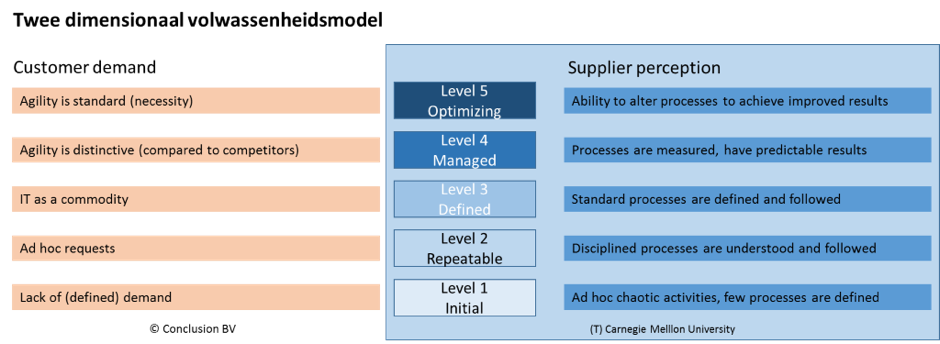My previous blog on the value of non-IT supporting processes and tools got me thinking – there’s something missing, a gap, in most maturity models that I’ve seen and used. Don’t get me wrong, I believe in the power of such models. It’s my experience that they provide a good handle for discussion and situational awareness. And good, i.e. simple, models have the power to motivate people to achieve more.
I haven’t really researched it, but I reckon that most maturity models are derived from one in particular – the Capability Maturity Model Integration (CMMI) model. Which in turn was derived from the “stages of growth” model which was described in the 1970s by Richard Nolan.
Back to that missing element – the maturity models gap
Maturity models such as CMMI look at a topic from one perspective only. It’s the point of view of the provider that delivers a service. By using this, or any other model, this provider claims to be in control of its processes to a certain degree. However, in the current complex world of high performance organizations, multi-level outsourcing, and organized demand and supply, this is simply not sufficient.
A common complaint about maturity models is that organizations tend to aim for the highest level of maturity without looking at the costs (and benefits) involved, and without asking their customer(s) which level is actually needed. Or, at the other end of the spectrum, organizations keep a low level of maturity while their customers demand a much higher level of achievement.
Matching maturity to actual need
The above brings me to the conclusion that the level of organizational maturity only matters when there’s a gap between customer demand and supplier perception of what is needed. Sounds logical, doesn’t it? The thing is, that for maturity models to properly support this, it needs two dimensions. And only when it contains both the customer AND supplier perspectives, can it serve as an intermediary to facilitate any discussions on the matter.
Sure, I see maturity models that refer to business value. But they tend to be general, as they show a graph with one axis with either high or low value. I made an attempt to add an extra dimension to the CMMI model below:
Example of a Two-Pillar Maturity Model

I should stress that the part in blue is not from my hand, but belongs to the friendly people of Carnegie Mellon University.
Using two-dimensional maturity models
Adding an extra dimension to maturity models saves time and therefore money. Then discussions about service levels and service portfolio are likely to be easier and shorter. And levels of maturity that are irrelevant to the customers’ needs are no longer aspired to.
In the maturity model pictured above, two aspects become clear to me:
- In the lower levels, the supplier is a cost center. In the upper levels, it’s a value center where investments on the supplier side create value on the demand side.
- Commoditization is possible: where a drop in “expectations” – from higher to lower levels – on both the supplier and demand sides is very well possible. For instance, an internet bank would have once been based on state of the art technology. Nowadays, the IT components of an internet bank could be purchased as a standard SaaS solution.
Where does this take us with maturity models?
Using this representation of maturity models with customers, I’ve found it to be threshold-reducing to both the business organization and the IT supplier in terms of having a constructive discussion about service expectations and (im)possibilities.
Do you use standard maturity models, perhaps the ITIL Maturity Model, or have you tweaked them to serve your purpose better? If you have, I’d love to know what you’ve done and what you’ve achieved.
Michiel Croon
Michiel Croon is a service management consultant working for Dutch IT service provider Conclusion. He tends to add creativity to boring topics, taking a generic approach to solve specific problems. He has worked as a team lead, project manager, coach, trainer and advisor to customers in all sectors and regions of the Dutch economy. One of his favorite oneliners is “A fool with a tool is still a fool” which also happens to be his Twitter handle. Michiel is a fan of story telling and tends to make (and keep) organizational performance measurable.


2 Responses
Since most service providers have more than one customer and it is likely that each customer will have different types of demand – I don’t see this at all as being levels of maturity, but that is another question – then this means that the service provider will simultaneously have different maturity levels, each depending on the particular customer. Only to be expected in a relativistic world.
This line of thinking was published in 1996 by KPMG. I’ve quoted their instrumental approach many times in my publications. Check figure 3.7 in the latest book on the USM Method. You must have read about the KPMG model many times 🙂